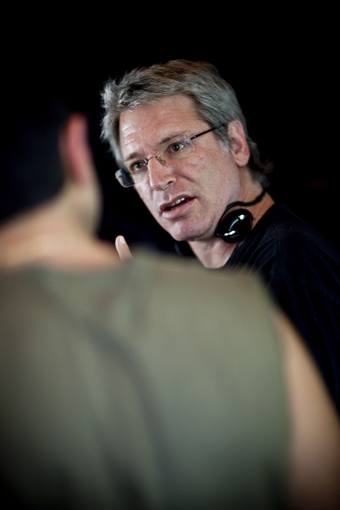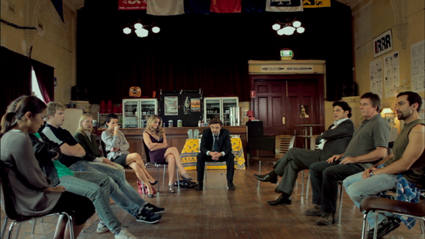in the filmmaking crucible
julian wood: interview michael rymer, director, face to face

Michael Rymer
photo Dennys Ilic
Michael Rymer
LOCATING AUSTRALIAN DIRECTOR MICHAEL RYMER IN A LARGE HARBOURSIDE HOTEL COULD BE A CHALLENGE. HE’S BURIED AMONGST THE POTTED PALMS AND SURROUNDED BY WHAT LOOKS LIKE A WHOLE CONVENTION OF JAPANESE FLIGHT ATTENDANTS. THE DIRECTOR PROBABLY HAS A WEARISOME SLEW OF THESE INTERVIEWS BUT HE IS CHARMING AND RELAXED COMPANY. WITH HIS CRISP BLUE SHIRT AND TANNED FEATURES HE HAS A LOOK THAT ONE COULD DESCRIBE AS ‘CALIFORNIAN HEALTHY.’ RYMER, ORIGINALLY FROM MELBOURNE, HAS INDEED SPENT QUITE A LOT OF TIME IN NORTH AMERICA HAVING GONE TO FILM SCHOOL IN NEW YORK AS A VERY YOUNG MAN. “I AM A LITTLE BIT TRANSPACIFIC” HE SAYS, AND IF YOU LISTEN CAREFULLY YOU CAN DETECT VERY FAINT TRACES OF AN AMERICAN TWANG.
In 1995 Rymer burst on to the Australian scene with the quirky, utterly brilliant Angel Baby, an oddball love story starring the inimitable Jacqueline Mackenzie. Pretty soon Rymer was off to North America. He spent quite a lot of time in Vancouver where he worked for years on the highly cult sci-fi Battlestar Galactica (once described as ‘Star Trek for grown-ups’). Rymer loved working on it and says it taught him a hell of a lot about how to hold audiences with just timing and good directing. “It’s dark and broody. But we shot five or six pages of script a day so I learned some tricks about covering material fast and keeping an audience on its toes.”
He needs these skills for his return-to-Australia film Face to Face, which has secured a lot of festival notice including more than one audience selection. Given that it is in some ways a tough watch, Rymer is pleased with those non-critical accolades. When I tell him I have only seen the film with other critics he urges me to see it again “with a real audience.”

Face to Face
Face to Face was born out of Rymer’s encounter, via his friend David Moore, with the alternative approach to crime resolution known as Restorative Justice. They both thought it would make the basis for some incredible drama. So did playwright David Williamson and he wrote a play based on the idea. To some Williamson is a ‘national treasure’; to others he is someone who grasps abstract issues better than real characters. Rymer says Williamson can sometimes get depressed about those accusations. He told his friend not to worry as he would surely outlast his critics. Rymer took on the challenge of converting the play to the screen whilst avoiding staginess. He showed the drafts to Williamson and was pleasantly surprised how smoothly it all went. “I was a little bit nervous showing it to him but he was very generous. He must have liked what I did as he didn’t change much at all.”
We talk about some of the other plays to film adaptations. Rymer recalls Robert Altman (a big influence) coming to his film school and showing them Streamers (1983). More recently there was Nicolas Hytner’s filming of his stage-directed History Boys (2006). The best analogy for Rymer though is Sydney Lumet’s first film: “I love that. I would like to think of this film as an Australian contemporary Twelve Angry Men (1957).”
The look of the film is very much down to its location. Apart from a few strategic flashbacks to open it up, the whole shoot was done in a big Trades Hall in central Melbourne. Rymer turns out to be a pretty good location scout too: “I knew I had to find a place that had great texture and light. That is the look of the whole movie. It was actually a working bar too so at night we had to pack up the whole shoot!”
The film was shot using available light. Rymer was initially worried as the film was pioneering the use of new compact digital cameras—the Canon D series. “I remember we had to wait for a special patch to convert to film frame speed.” Although the cameras were forgiving, the rapid intense shoot does make one nervous. As Rymer says, “the one thing with that kind of shoot is that there is no margin for error. If just one of the actors had not been on form, or if something technical had gone wrong, then you are in trouble.”
Rymer’s strong suit is his amazing cast with at least four well-known names and some excellent support players. Rymer was canny about this aspect too. It helped that some of the cast lived in the city where it was shot and that the shoot took only about two weeks of their busy lives. “The trick is to ask people really late. If you ask them too early—and there’s little money in it—they are unlikely to block out that period of time or avoid better paid work.” Given that the film is about victims and perpetrators confronting the past and each other, it can get very intense. Rymer describes the shoot as a ‘crucible’: “I am a believer in the idea that what happens behind the camera affects what’s in front and vice versa. We benefited from an intense shoot I think. We didn’t have time to rehearse too much and over-think it. You need very good actors to do that of course.”
Although the film has meaty roles for Matthew Newton and Vince Colosimo and Luke Ford (the up and coming actor from Black Balloon and Red Dog) it was actually anchored around Sigrid Thornton. “She was first person on board and that is important. She was a friend I had always wanted to work with. The movie doesn’t really belong to her character but she is so good, so generous. She even co-wrote a monologue (approved by Williamson) which adds to her character.”
There’s no big PR and marketing budget either so the film will depend a lot on word of mouth. Rymer was pleased the film got the audience vote at the recent Melbourne International Film Festival. He hopes the package as a whole will intrigue people: “It’s a home-grown film and privately funded. We just think we will take it to the ‘court of public opinion’.”
Face to Face, direction, screenplay Michael Rymer, from the play by David Williamson; distributor Australian Film Syndicate, 2011
RealTime issue #105 Oct-Nov 2011 pg. 24






